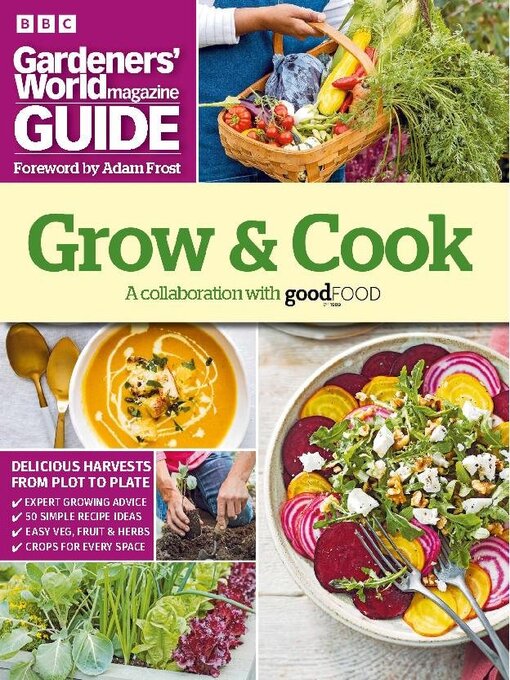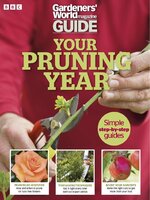Gardeners' World Magazine is the authoritative voice in gardening, the clear market-leader since it launched in 1991. The award-winning editorial includes topical, practical advice in the readers' favourite 'what to do now' section, and regular contributions and features from the top names in BBC gardening. Packed with fresh ideas and clear advice - the innovative approach offers creative, practical and problem-solving solutions to all keen gardeners.
Welcome
Get your garden ready for growing • Don’t have a veg plot yet? Or not sure how to start growing food on the patio? Here are some easy ways to get started
Why growing your own is best • Take advantage of all these feel-good reasons to get sowing and planting
Tips for container-growing success
Crop by crop
Root crops • These heavy-duty crops are some of the easiest to grow and also some of the most rewarding. Best grown in deep, fertile soil that holds on to moisture well, some initial planting and sowing in spring will give very substantial crops throughout the year. Parsnips and carrots need light, free-draining soil in order to create impressive long, well-shaped roots, while beetroot, potatoes and celeriac are excellent choices for growing in potentially tricky clay soil.
Peas and beans • Summer just isn’t the same without the sweet flavour of fresh peas picked from the garden, or feeling the soft fuzzy pods of broad beans as you pop them to reveal their tasty bounty. Then there is the glorious glut of French and runner beans that crop daily for weeks during the second half of summer. Peas and beans are crops for a sheltered, sunny space with deep soil that holds on to moisture. They are also perfect in raised beds that have been topped up with a generous helping of rotted compost.
Brassicas • This group of superfoods do a lot of hard work in the veg garden, soldiering on through the winter months to provide a nutritious harvest in the cold dark days. They also know how to give their best in summer too, with early varieties of fresh cabbage, cauliflower and calabrese to harvest for sumptuous stir fries. These vegetables grow best on firm, chalky/alkaline soils, rather than thin, sandy, acidic ones. If your soil is acidic, then it will be best to grow them in containers.
Salads • Get in the habit of sowing and planting little and often and it’s possible to be near self-sufficient in home-grown salad for many months of the year. Bags of salad leaves are pricey in the supermarket and they don’t come with the satisfaction that growing your own gives. Make maximum use of your space by sowing leafy crops in between bigger ones while there is bare soil around them. Also gather together empty pots, fill them with compost and, in no time, you’ll have some fresh leaves to pick.
The tomato family • These fruiting crops have a soft spot for the sun and warm weather, so they’ll jump at the chance to be grown in a greenhouse or polytunnel. But they can still grow well in a sunny, sheltered spot outside, and they’ll need a little less watering that way too. Planted out at the end of May, tomatoes, chillies, sweet peppers and aubergines begin to fruit in the second half of summer, and the harvest continues well into autumn.
Perennial crops • It’s good to have a few crops in the garden that will keep coming back year after year so that, whatever life throws at you, they will pop up and keep producing, even if lots of sowing and planting hasn’t been possible. And that’s where these perennial veg, literally step up to the plate
Squashes • Whether you grow pumpkins, courgettes, marrows or butternut squashes to store for winter, you’ll definitely find you’re getting value for money. The key to heavy crops is good soil and regular watering and feeding. Just a little attention can lead to some...

 Jan 01 2025
Jan 01 2025
 Year Planner 2025
Year Planner 2025
 Dec 01 2024
Dec 01 2024
 Nov 01 2024
Nov 01 2024
 Your Happy Houseplants 2024
Your Happy Houseplants 2024
 Creative Christmas 2024
Creative Christmas 2024
 Oct 01 2024
Oct 01 2024
 The Thrifty Gardener 2024
The Thrifty Gardener 2024
 Sep 01 2024
Sep 01 2024
 Aug 01 2024
Aug 01 2024
 Gardening for Shade 2024
Gardening for Shade 2024
 Jul 01 2024
Jul 01 2024
 Creative Containers 2024
Creative Containers 2024
 Jun 01 2024
Jun 01 2024
 Grow & cook 2024
Grow & cook 2024
 May 01 2024
May 01 2024
 Grow your own 2024
Grow your own 2024
 Apr 01 2024
Apr 01 2024
 Your Garden From Seed 2024
Your Garden From Seed 2024
 Your pruning Year 2024
Your pruning Year 2024
 Mar 01 2024
Mar 01 2024
 Feb 01 2024
Feb 01 2024
 Small Space Harvests 2024
Small Space Harvests 2024
 Jan 01 2024
Jan 01 2024
